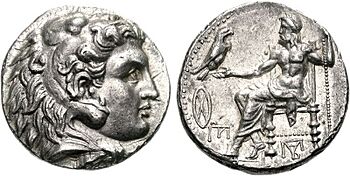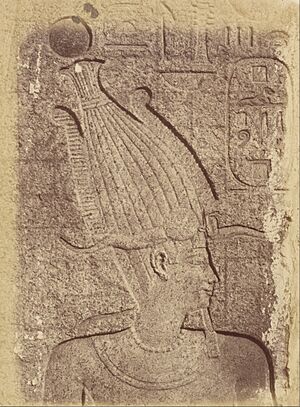Philip III of Macedon facts for kids
Quick facts for kids Philip III |
|
|---|---|

|
|
| King of Macedonia | |
| Reign | 323–317 BC |
| Predecessor | Alexander III |
| Successor | Alexander IV |
| Co-rulers | Alexander IV (323–317) |
| Pharaoh of Egypt | |
| Reign | 323–317 BC |
| Predecessor | Alexander III |
| Successor | Alexander IV |
| King of Persia | |
| Reign | 323–317 BC |
| Predecessor | Alexander III |
| Successor |
|
| Born | Arrhidaeus c. 357 BC |
| Died | 317 BC |
| Spouse | Adea Eurydice |
| Dynasty | Argead dynasty |
| Father | Philip II |
| Mother | Philinna of Larissa |
| Religion | Ancient Greek religion |
Philip III Arrhidaeus (born around 357 BC – died 317 BC) was a king of Macedonia. He ruled from 323 BC until his death in 317 BC. He was the son of King Philip II of Macedon and Philinna of Larissa. This made him the older half-brother of Alexander the Great. His birth name was Arrhidaeus, but he took the name Philip when he became king.
As Arrhidaeus grew up, it became clear he had some learning challenges. Some ancient writers, like Plutarch, believed that Queen Olympias, Philip II's wife, tried to harm him. She wanted to remove him as a possible rival to her own son, Alexander. However, many modern experts doubt this story.
Alexander the Great cared for Arrhidaeus. He took him on his military campaigns. This helped keep Arrhidaeus safe and prevented others from using him to challenge Alexander's rule. After Alexander died in Babylon in 323 BC, the Macedonian army in Asia named Arrhidaeus as king. But he was mostly a figurehead, meaning others made the real decisions. He was often used by powerful generals.
Contents
Biography of Philip III
Even though Arrhidaeus and Alexander were about the same age, Arrhidaeus was never seen as a serious choice to take over from Philip II. Still, when the Persian ruler of Caria, Pixodarus, offered his daughter for Alexander to marry, Alexander refused. Instead, he offered his brother Arrhidaeus as a husband. Alexander wanted to stop this marriage. He worried it might create a new heir to the throne before he did. This made his father, Philip II, quite annoyed in 337 BC.
We don't know much about what Arrhidaeus did during Alexander's reign. For 13 years (336–323 BC), he was not given any military or government roles.
Becoming King
Arrhidaeus was in Babylon when Alexander died on June 10, 323 BC. This led to a big problem over who would rule next. Arrhidaeus was the most obvious choice, but he needed help with ruling because of his mental challenges.
A disagreement started between Perdiccas, a cavalry leader, and Meleager, who led the army's main fighting force. Perdiccas wanted to wait to see if Roxana, Alexander's pregnant wife, would have a son. Meleager, however, thought Arrhidaeus should be chosen as king right away.
They reached a compromise: Arrhidaeus would become king, taking the name Philip III. If Roxana's child was a boy, he would also become king alongside Philip. This did happen, and Roxana's son, Alexander, became co-ruler with his uncle Philip. It was decided that Philip Arrhidaeus would reign but not truly rule. The new regent, Perdiccas, would make the decisions.
When news reached Macedonia that Arrhidaeus was chosen as king, Cynane, a daughter of Philip II, made a plan. She wanted to travel to Asia and offer her daughter Eurydice to the new king as his wife. This move upset Perdiccas, the regent, because Cynane had ignored his authority. To stop the marriage, Perdiccas sent his brother, Alcetas, to kill Cynane.
However, the soldiers were very angry about Cynane's death. Because of their reaction, Perdiccas had to allow the marriage. From that moment on, Philip Arrhidaeus was greatly influenced by his new wife, Eurydice. She was a strong and determined woman who wanted to make her husband's power real.
New Regents

Eurydice got a chance to increase her husband's power when the first war of the Diadochi ended Perdiccas's rule. A new agreement was needed. This agreement was made at Triparadisus in Syria in 321 BC. Eurydice skillfully managed to remove the first two chosen regents, Peithon and another Arrhidaeus. But she could not stop Antipater, who was very powerful. Antipater became the new regent. Philip Arrhidaeus and Eurydice had to go back to Macedonia with Antipater.
The next year, Antipater died naturally. He chose his friend Polyperchon as his successor, not his own son Cassander. Cassander refused to accept his father's choice. This started the Second War of the Diadochi. Eurydice saw this as another chance to free Philip from the regent's control.
In 317 BC, Cassander forced Polyperchon out of Macedonia. Eurydice quickly joined forces with Cassander. She convinced her husband to name Cassander as the new regent. Cassander then left Eurydice in charge of Macedonia when he went to fight in Greece.
Death of Philip III
In that same year (317 BC), Polyperchon and Olympias joined with Aeacides, the king of Epirus. They invaded Macedonia. The Macedonian soldiers refused to fight Olympias, who was Alexander the Great's mother. Philip and Eurydice had to try to escape. But they were caught at Amphipolis and put in prison.
Soon, it became clear that Philip was too dangerous to be kept alive. Many of Olympias's enemies could use him against her. So, Olympias had him killed. His wife, Eurydice, was forced to end her own life.
Tomb Discoveries

In 1977, archaeologists found three Macedonian tombs near Vergina in northern Greece. Tomb II was a royal tomb with two rooms. It had many valuable items, like silver pots, bronze weapons, and a gold-and-ivory shield. The first room of the tomb held a golden box with the bones of a woman in her twenties. The inner room had another gold box with a golden crown and the bones of a man in his forties.
Professor Manolis Andronikos, the lead archaeologist, and other experts believed Tomb II held the remains of Philip II and his wife Cleopatra Eurydice. They thought this because of the tomb's rich decorations, the age of the bones, and damage found on the male skeleton's right eye socket and thigh bone. Philip II had lost his right eye in battle and had a leg injury. However, the eye socket was too damaged to be sure, and the leg wound was on the wrong leg.
Pottery found in the tomb was from a later time (late 4th to early 3rd century BC), but Philip II died in 336 BC. Also, the tomb's vaulted roof looked like tombs built after Alexander the Great's invasion of Asia.
Because of new studies in 2015, many now believe Philip II was buried in Tomb I. This means Tomb II likely holds the remains of Philip Arrhidaeus and his wife Eurydice. This fits with the time of their deaths in 317 BC. It is also known that Arrhidaeus received special honors when he was buried.
In Tomb II, there were greaves (armor for the lower leg). Many archaeologists thought these belonged to Philip II. But Antonios Bartsiokas, a lead author of the 2015 study, suggested they could belong to Eurydice or even Alexander the Great. Bartsiokas explained that Eurydice was a warrior who fought in battles and might have needed greaves. It's also possible that some of Alexander the Great's armor was buried there. Arrhidaeus wore Alexander's clothes when he became king in 323 BC, even though he didn't fight in battles himself. An iron helmet found in Tomb II also matches how Plutarch described Alexander's helmet.
Images for kids
-
A coin of Philip III Arrhidaios, made in Babylon between 323-320 BC. It was struck under Perdikkas.
-
The Golden Larnax (a gold box) with the Sun of Vergina symbol on its lid. It holds bones and a royal golden wreath. This artifact is displayed in the underground museum of Vergina.
See also
 In Spanish: Filipo III de Macedonia para niños
In Spanish: Filipo III de Macedonia para niños





